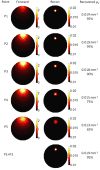Photo-magnetic imaging: resolving optical contrast at MRI resolution
- PMID: 23640084
- PMCID: PMC4031318
- DOI: 10.1088/0031-9155/58/11/3551
Photo-magnetic imaging: resolving optical contrast at MRI resolution
Abstract
In this paper, we establish the mathematical framework of a novel imaging technique, namely photo-magnetic imaging (PMI). PMI uses a laser to illuminate biological tissues and measure the induced temperature variations using magnetic resonance imaging (MRI). PMI overcomes the limitation of conventional optical imaging and allows imaging of the optical contrast at MRI spatial resolution. The image reconstruction for PMI, using a finite-element-based algorithm with an iterative approach, is presented in this paper. The quantitative accuracy of PMI is investigated for various inclusion sizes, depths and absorption values. Then, a comparison between conventional diffuse optical tomography (DOT) and PMI is carried out to illustrate the superior performance of PMI. An example is presented showing that two 2 mm diameter inclusions embedded 4.5 mm deep and located side by side in a 25 mm diameter circular geometry medium are recovered as a single 6 mm diameter object with DOT. However, these two objects are not only effectively resolved with PMI, but their true concentrations are also recovered successfully.
Figures





Similar articles
-
Multi-Wavelength Photo-Magnetic Imaging System for Photothermal Therapy Guidance.Lasers Surg Med. 2021 Jul;53(5):713-721. doi: 10.1002/lsm.23350. Epub 2020 Nov 10. Lasers Surg Med. 2021. PMID: 33169857 Free PMC article.
-
A True Multi-modality Approach for High Resolution Optical Imaging: Photo-Magnetic Imaging.Proc SPIE Int Soc Opt Eng. 2014 Feb 19;8937:89370G. doi: 10.1117/12.2040870. Proc SPIE Int Soc Opt Eng. 2014. PMID: 25767691 Free PMC article.
-
Ex vivo validation of photo-magnetic imaging.Opt Lett. 2017 Oct 15;42(20):4171-4174. doi: 10.1364/OL.42.004171. Opt Lett. 2017. PMID: 29028040 Free PMC article.
-
Implementation of a phase array diffuse optical tomographic imager.Rev Sci Instrum. 2008 Aug;79(8):084301. doi: 10.1063/1.2963042. Rev Sci Instrum. 2008. PMID: 19044366
-
Magnetic resonance thermometry and its biological applications - Physical principles and practical considerations.Prog Nucl Magn Reson Spectrosc. 2019 Feb;110:34-61. doi: 10.1016/j.pnmrs.2019.01.003. Epub 2019 Jan 31. Prog Nucl Magn Reson Spectrosc. 2019. PMID: 30803693 Free PMC article. Review.
Cited by
-
An accelerated photo-magnetic imaging reconstruction algorithm based on an analytical forward solution and a fast Jacobian assembly method.Phys Med Biol. 2016 Oct 21;61(20):7448-7465. doi: 10.1088/0031-9155/61/20/7448. Epub 2016 Oct 3. Phys Med Biol. 2016. PMID: 27694717 Free PMC article.
-
Comprehensive analytical model for CW laser induced heat in turbid media.Opt Express. 2015 Nov 30;23(24):31069-84. doi: 10.1364/OE.23.031069. Opt Express. 2015. PMID: 26698736 Free PMC article.
-
Resolving tissue chromophore concentration at MRI resolution using multi-wavelength photo-magnetic imaging.Biomed Opt Express. 2020 Jul 10;11(8):4244-4254. doi: 10.1364/BOE.397538. eCollection 2020 Aug 1. Biomed Opt Express. 2020. PMID: 32923039 Free PMC article.
-
Multi-Wavelength Photo-Magnetic Imaging System for Photothermal Therapy Guidance.Lasers Surg Med. 2021 Jul;53(5):713-721. doi: 10.1002/lsm.23350. Epub 2020 Nov 10. Lasers Surg Med. 2021. PMID: 33169857 Free PMC article.
-
Experimental validation of a high-resolution diffuse optical imaging modality: photomagnetic imaging.J Biomed Opt. 2016 Jan;21(1):16009. doi: 10.1117/1.JBO.21.1.016009. J Biomed Opt. 2016. PMID: 26790644 Free PMC article.
References
-
- Arridge SR. Optical tomography in medical imaging. Inverse Problems. 1999a;15:R41.
-
- Arridge SR. Optical tomography in medical imaging. Inverse Problems. 1999b;15:R41–R93.
-
- Blyschak K, Simick M, Jong R, Lilge L. Classification of breast tissue density by optical transillumination spectroscopy: optical and physiological effects governing predictive value. Med Phys. 2004;31:1398–414. - PubMed
-
- Brooksby B, Pogue BW, Jiang S, Dehghani H, Srinivasan S, Kogel C, Tosteson TD, Weaver J, Poplack SP, Paulsen KD. Imaging breast adipose and fibroglandular tissue molecular signatures by using hybrid MRI-guided near-infrared spectral tomography. Proceedings of the National Academy of Sciences of the United States of America. 2006;103:8828–33. - PMC - PubMed
Publication types
MeSH terms
Grants and funding
LinkOut - more resources
Full Text Sources
Other Literature Sources
Medical
